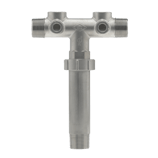Before purchasing a tank tee, there are a number of things you need to determine first. In a previous blog, we discussed figuring out the tank connection specifications and the tank connection fitting materials.
In this blog, we will look at two more bonus key details you need to establish before you can accurately select a tank tee that will be a perfect fit for your system.
If you didn't have a chance to read our blog, 2 Important Factors When Purchasing a Tank Tee, check it out here.
The two key factors:
- Union vs Non Union
-
Tank Tee Packages
1. Union vs Non-Union
One important question a salesperson will ask when you are ordering a tank tee is if you require a union or non-union tank tee.
Hmm.. what's the difference?
Union Tank Tees
Union tank tees, as you can see in the picture, include a union that allows you to remove the head from the body of the tank tee.
head from the body of the tank tee.
The primary benefit of a union tank tee is that it makes the replacement of the pressure tank easier, meaning your plumbed-in tank tee doesn't need to be disassembled from the main supply lines in the home. You have the opportunity to detach the pressure tank and remove it much more independently of the tank tee package.
Union tank tees are available in a variety of styles and materials allowing for quick and easy replacement of the tank when required.
Typically, union tank tees are the most recommended since it makes replacing a part smooth and fast. Particularly for pressure tanks with joints underneath the tank, a union means you don't need to reach underneath your pressure tank which can be a cumbersome process.
 Non-Union Tank Tee
Non-Union Tank Tee
Non-union Tank Tees do not include a union, which means you do not have the ability to remove the head from the body. Without the union, you would have to take apart the whole tank tee if something needs removed or replaced. Similar to the union tank tee, the non-union are available in a variety of sizes and materials.
Union tank tees give the ability to disconnect the tank, leaving all the other plumbing and electrical wiring intact. You can simply disconnect the tank at the union, lift out the tank, then the leg portion can be unthreaded from the old tank and easily installed into the new tank. Simply place it back into position then reconnect using the union nut.
A non-union tank tee does not offer this flexibility, but instead requires that the entire tank tee package be threaded off of the pressure tank.
While the cost of a union tank tee is more than its non-union counterpart, the time savings (and general headache) of a union tank tee is often well worth the cost to the average contractor.
2. Tank Tee Packages
A tank tee's main function (when attached to a pressure tank) is to allow other important parts of a water system to be attached in a straightforward manner. These other important components that your system needs could be boiler drains, relief valves, nipples, pressure gauges & pressure switches. Each component plays a very important role in the success of your system.
But just like tank tees, there are many variations that each of those components can come in. There is no such thing as a standard pressure gauge or relief valve. As a result, you need to know that you're choosing the right variation for your tank tee. But with all these extra parts and their combinations, how do you know that you're pairing the right items?

The easiest way to ensure you are purchasing the correct material, size and differential is to purchase a tank tee package. By buying the tank tee package, you eliminate the possibility of purchasing the wrong part, wasting your time (with returns + reordering) and potentially wasting your money.
The tank tee package should always ensure that the parts will work perfectly with your tank tee / water system because they have been specifically selected and paired to do so.
Caution Ordering Individual Components: If you were to purchase a 40-60 pressure switch (for example), it may actually operate closer to 65 if it wasn't calibrated properly. If you then have a 75 PSI relief valve that is closer to 70 PSI, there could, in theory, be a premature activation of the relief valve, flooding the area around your pressure tank.
It's important to note that this is a rare and extreme circumstance, but is entirely possible in theory. Exercise caution if you are selecting your own components for a tank tee system.
In Summary:
Now you know a few more important factors to determine what kind of tank tee you should order. Once again, this complicated or confusing product is really not too bad when you understand a few key aspects of the product.
Have further questions about this subject?

Head over to Boshart's Knowledge Base: technical product information, guidelines, and more.


![[Video] How to Properly Measure your Tank Tee](https://blog.boshart.com/hubfs/20.jpg)
![[Video] 2 Important Factors When Purchasing a Tank Tee](https://blog.boshart.com/hubfs/15.jpg)

SHARE